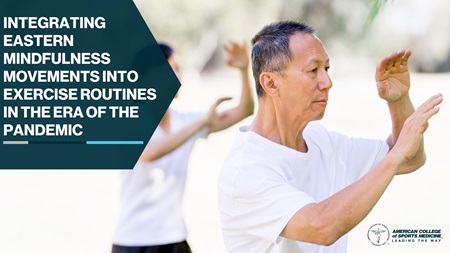by
Greg Margason
| May 24, 2022
 Take a look at the mass media and social media you are currently watching or reading in the month of May. What do you see? Most likely, you see articles mentioning Mental Health Awareness Month, Asian American and Pacific Islander Heritage Month, and exercise or physical activity recommendations in the era of the COVID-19 pandemic. If you are asked to incorporate these three elements into a practical program in a real-world setting, you may wonder how you could put the pieces together. The answer is simple — integrating Eastern mindfulness movements (e.g., tai chi, qigong, yoga) into our exercise routines. Mindful movements are exercises that bring your attention to your breathing and the movements of your body; oftentimes they lead to a meditative state of mind. Hence, they are also known as “meditative movements.”
Take a look at the mass media and social media you are currently watching or reading in the month of May. What do you see? Most likely, you see articles mentioning Mental Health Awareness Month, Asian American and Pacific Islander Heritage Month, and exercise or physical activity recommendations in the era of the COVID-19 pandemic. If you are asked to incorporate these three elements into a practical program in a real-world setting, you may wonder how you could put the pieces together. The answer is simple — integrating Eastern mindfulness movements (e.g., tai chi, qigong, yoga) into our exercise routines. Mindful movements are exercises that bring your attention to your breathing and the movements of your body; oftentimes they lead to a meditative state of mind. Hence, they are also known as “meditative movements.”
COVID-19 poses a significant risk, particularly older adults and those with cardiometabolic diseases. The response to the pandemic has also led to a reduction in individuals’ physical activity, an increase in sedentary behavior, and a decrease in social contact and support — which in turn has caused mental health issues among numerous people since the start of the pandemic. Therefore, it is imperative we promote individuals’ mental health and well-being, ideally through holistic and feasible approaches that can be done at home or in community centers.
Tai chi, qigong and yoga, the three most popular mind-body practices in the United States, can be excellent choices. These mindful movements are known to increase strength and flexibility, improve sleep quality and alleviate pain. They also provide significant benefits to mental health, such as increasing self-awareness, creating a sense of calmness, reducing stress and anxiety, and enhancing mood. A scientific review in 2018 confirmed that tai chi, qigong and yoga could be effective non-pharmacological modalities in the management of depression and anxiety — and unfortunately, depressive symptoms increased by 25% worldwide during the pandemic.
Let us take tai chi, a form of mind-body exercise that originated in China, as an example. Tai chi comprises Chinese martial arts and meditative movements that enhance the well-being of the mind and body. The slow, continuous and mindful movements and dance-like postures flow into each other, making tai chi an ideal exercise modality to practice at home or in small groups. Prior to the pandemic, people practiced tai chi in small groups in a variety of settings, like parks, YMCAs and community centers. Research evidence suggests tai chi programs have positive effects on individuals’ immune systems, inflammation reduction, rehabilitation in respiratory diseases and emotional improvement. Also, practicing tai chi requires limited space and no extra equipment, so it can be practiced at home or in a nearby park, making it possible for us to maintain an active lifestyle during the pandemic and cope with COVID-19 adversities.
Since the outbreak of COVID-19, researchers and practitioners have been creative in taking advantage of emerging technology to deliver tai chi programs remotely to groups of learners. Delivering tai chi programs virtually via Zoom meetings has increased in popularity during the pandemic. For example, the co-author of this blog, a certified tai chi instructor, taught a virtual evidence-based fall-prevention program, Tai Ji Quan: Moving for Better Balance, to a group of older adults in 2021 and another Yang-style, 24 forms tai chi program for nearly 20 middle-aged women in 2022 using Zoom. Both classes were well received by the participants. One of the most frequent comments received from the participants was the benefit of stress reduction.
Given the ubiquitous nature of modern-day technology, professionals and practitioners are seeking to leverage several e-health technologies (e.g., smartphone apps and virtual reality) to help individuals practice tai chi with a virtual instructor. For example, 7 Minute Chi is one of the most popular tai chi apps on the Apple Store. The movements are easy to follow without in-person instructions, and it is beginner friendly. On the other side, the Learn Tai Chi app is ideal for people who have experience practicing tai chi.
Virtual reality is considered a cutting-edge technology, possessing great potential in promoting a tai chi practice due to its fun and interactive features. Guided Tai Chi is a virtual reality game that is available on Oculus Quest 2. It guides players through over 200 tai chi-inspired workouts ranging from 3 minutes up to 60 minutes across 20 arcade sessions (i.e., virtual natural environments). The game uses Quest’s motion controllers or players’ hand-tracking to instruct the person through slow and thoughtful motions. It features several tai chi styles of movements with a virtual instructor. Individuals learn the basic movements by following visual instructions, including connecting dots. The user can enjoy relaxing exercises, combining elements of several tai chi styles. In addition to a fully immersive virtual reality tai chi game, Tai Chi for Beginners is another option for the non-immersive virtual reality game on the Xbox gaming platform. This game has eight easy-to-follow lessons teaching tai chi postures with clear, step-by-step instructions. It should be noted that most, if not all, tai chi apps and virtual reality games usually charge some fees upon purchase.
To celebrate Mental Health Awareness Month and Asian American and Pacific Islander Heritage Month in May, we as kinesiologists and health professionals can introduce Eastern mindfulness movements into exercise routines with the goal of promoting mental health and well-being among our communities. Although we only use tai chi as an example in this blog, we can also practice other Eastern mindfulness movements, such as yoga and qigong, through similar approaches. The development of holistic exercise and meditative programs will inform non-pharmacologic strategies for mental health promotion during the pandemic and beyond.
Access mental health resources
Related content:
Brochure | Selecting and Effectively Using a Yoga Program
Handout | Finding Your Motivation for Exercise
Article | Four Ways to Develop a Healthy Mindset
 Zan Gao, Ph.D., is a professor at the School of Kinesiology in University of Minnesota-Twin Cities, specializing in physical activity and health promotion. Dr. Gao’s research has primarily focused on promoting health through population-based physical activity interventions with emerging technologies such as active video games, virtual reality and health wearables. He has published three edited books, 28 book chapters, and 150 research articles in peer-reviewed journals. Dr. Gao has been the recipient of several international/national awards and the principal investigator of National Institute of Health and Robert Wood Johnson Foundation research grants. He is currently serving as an editorial board member for five professional journals and the associate editor for the Journal of Health and Sports Science and Research Quarterly for Exercise and Sports. Dr. Gao’s google h-index is 44. He is a fellow of American College of Sports Medicine®, and a fellow of the SHAPE America! Research Council.
Zan Gao, Ph.D., is a professor at the School of Kinesiology in University of Minnesota-Twin Cities, specializing in physical activity and health promotion. Dr. Gao’s research has primarily focused on promoting health through population-based physical activity interventions with emerging technologies such as active video games, virtual reality and health wearables. He has published three edited books, 28 book chapters, and 150 research articles in peer-reviewed journals. Dr. Gao has been the recipient of several international/national awards and the principal investigator of National Institute of Health and Robert Wood Johnson Foundation research grants. He is currently serving as an editorial board member for five professional journals and the associate editor for the Journal of Health and Sports Science and Research Quarterly for Exercise and Sports. Dr. Gao’s google h-index is 44. He is a fellow of American College of Sports Medicine®, and a fellow of the SHAPE America! Research Council.
 Yingying Chen, DNP, R.N., is a clinical assistant professor and is leading the Master of Science in Aging in Mandarin program at Edson College of Nursing and Health Innovation at Arizona State University. She received her initial nursing degree from Fujian University of Traditional Chinese Medicine and later completed the RN-BSN program at Saint Mary’s University of Minnesota. In 2018, she obtained her doctoral degree in integrative health and healing at the University of Minnesota’s School of Nursing. She has nearly a decade of clinical nursing experience working with older adults in various health care settings in both U.S. and China. She has a keen interest in holistic therapies and is a certified tai chi instructor and a reiki master. Dr. Chen’s greatest passion is to bridge health care between the West and the East and improve quality of life for older adults.
Yingying Chen, DNP, R.N., is a clinical assistant professor and is leading the Master of Science in Aging in Mandarin program at Edson College of Nursing and Health Innovation at Arizona State University. She received her initial nursing degree from Fujian University of Traditional Chinese Medicine and later completed the RN-BSN program at Saint Mary’s University of Minnesota. In 2018, she obtained her doctoral degree in integrative health and healing at the University of Minnesota’s School of Nursing. She has nearly a decade of clinical nursing experience working with older adults in various health care settings in both U.S. and China. She has a keen interest in holistic therapies and is a certified tai chi instructor and a reiki master. Dr. Chen’s greatest passion is to bridge health care between the West and the East and improve quality of life for older adults.